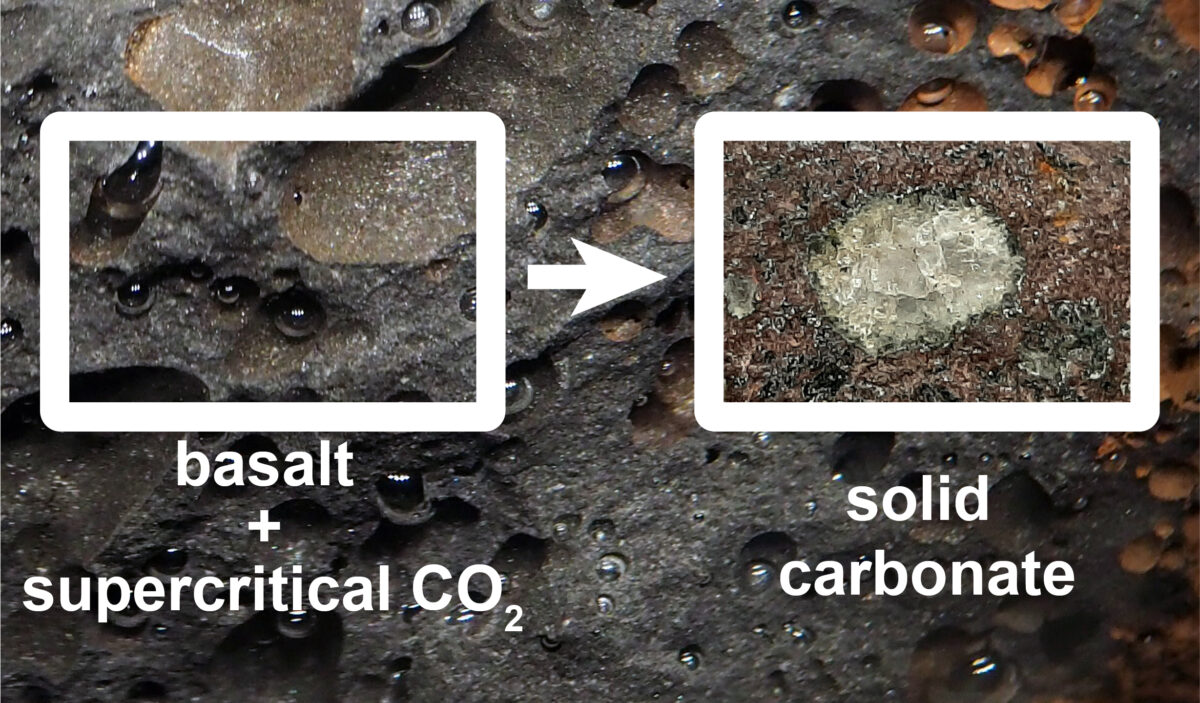
This long-term storage solution could help combat climate change
Scientists working on the Pacific Institute for Climate Solution’s (PICS) Solid Carbon Project have concluded that they have found a large-scale carbon dioxide (CO₂) storage solution to help combat climate change.
The Solid Carbon Project aims to draw CO₂ from the air and inject it into ocean basalt, a form of volcanic rock below the seafloor. When the CO₂ reacts with the basalt, it mineralizes into stable rock. This is a durable storage approach to removing CO₂ from the atmosphere and carrying out storage on a gigatron scale will aid in counteracting the roughly 51 gigatons of greenhouse gases (GHG) that human activity contributes to the atmosphere yearly.
Solid Carbon utilizes six separate technologies and combines them into an integrated system. First, Direct Air Technology in the ocean sucks in and extracts CO₂ from the atmosphere. Then the captured CO₂ is pumped below the seafloor, directly into the porous ocean basalt where the reaction takes place.
Kate Moran, president and CEO of Ocean Networks Canada, expressed the need for further funding to be able to fund a field demonstration at the Cascadia Basin. On the Solid Carbon website, it describes how a successful demonstration of these technologies could peg solid carbon as a “Global Climate Mitigation Solution” and “set the stage for rapid commercialization and global mass-scale deployment of the Solid Carbon solution needed for permanent CO₂ removal.”
“We’re really developing a base of know-how in B.C. so we could be the leading experts in the world,” said Moran in an interview with the Martlet. “That sets off a potential for an industry that could be really helping to transition those oil and gas workers to a more sustainable industry.”
History of the project
The Solid Carbon Project feasibility study, led by Oceans Networks Canada, formally began Oct. 1, 2019. However, Moran explained that it was in the works a few years before when a researcher at Columbia University in New York contacted Moran’s team. They wanted them to be a part of a study called CarbonSafe that was funded by the U.S. Department of Energy.
CarbonSafe looked at the pre-feasibility of sequestering CO₂ in the ocean basalt. It sought to determine the objectives, constraints, and the best potential path forward for this CO₂ project. They reached out, Moran states, because PICS was monitoring the best characterized ocean basalt in the world at Cascadia Basin on their Neptune Observatory. CarbonSafe acted as the basis for the Solid Carbon Project to continue researching.
Then, on Oct. 8, 2018, the Intergovernmental Panel on Climate Change (IPCC ) released a report on the impacts of global warming of 1.5°C above pre-industrial levels and related global greenhouse gas emission pathways.
“It just became clear that…we have to be removing CO₂ from the atmosphere in order to keep the planet habitable for humans,” said Moran.
Moran states that this prompted them to submit a proposal to the PICS in their first large competition to address the big issues in climate. “[The proposal would] basically look at, can we combine direct air capture of CO₂ on an ocean platform, and essentially create a system where it could be self-sustaining? And we could globally deploy these systems to be constantly pulling CO₂ out of the atmosphere and permanently removing it into ocean basalt,” said Moran.
The understanding that CO₂ will react with basalt and mineralize into rock over time was already proven in CarbFix, an experiment carried out in Iceland which began in 2007 and was doing its first pilot injections by 2012. This experiment used CO₂ in a dissolved state at shallow depths.
“They showed that it became rock in two years. So that’s why we were very confident that we can do this here as well. And the reason that we need to do this is because 95 or more per cent of basalt is in the ocean.” said Moran.
The alternate approach outlined by PICS scientists uses less water and involves directly injecting CO₂ into deep ocean basalt. In time, the injected CO₂ becomes solid rock.
For PICS, Moran hopes they can receive more funds from provincial and federal partners to assist their research. Now that they know that carbon capture on this large of a scale is feasible, they can begin to further research the implications of this new conclusion.
The future for carbon capture
One of the reasons why the project is receiving so much attention is because of the durability and longevity of their approach. However, Moran states that it is important to note that people can’t rely solely on these decarbonization technologies to combat climate change.
“We are going to need to do [decarbonization work] sometime before the mid century,” said Moran. “So that’s the reason we need to do the research now, so we’re ready by then. But in the meantime, it’s really important that we invest in decarbonizing.”








